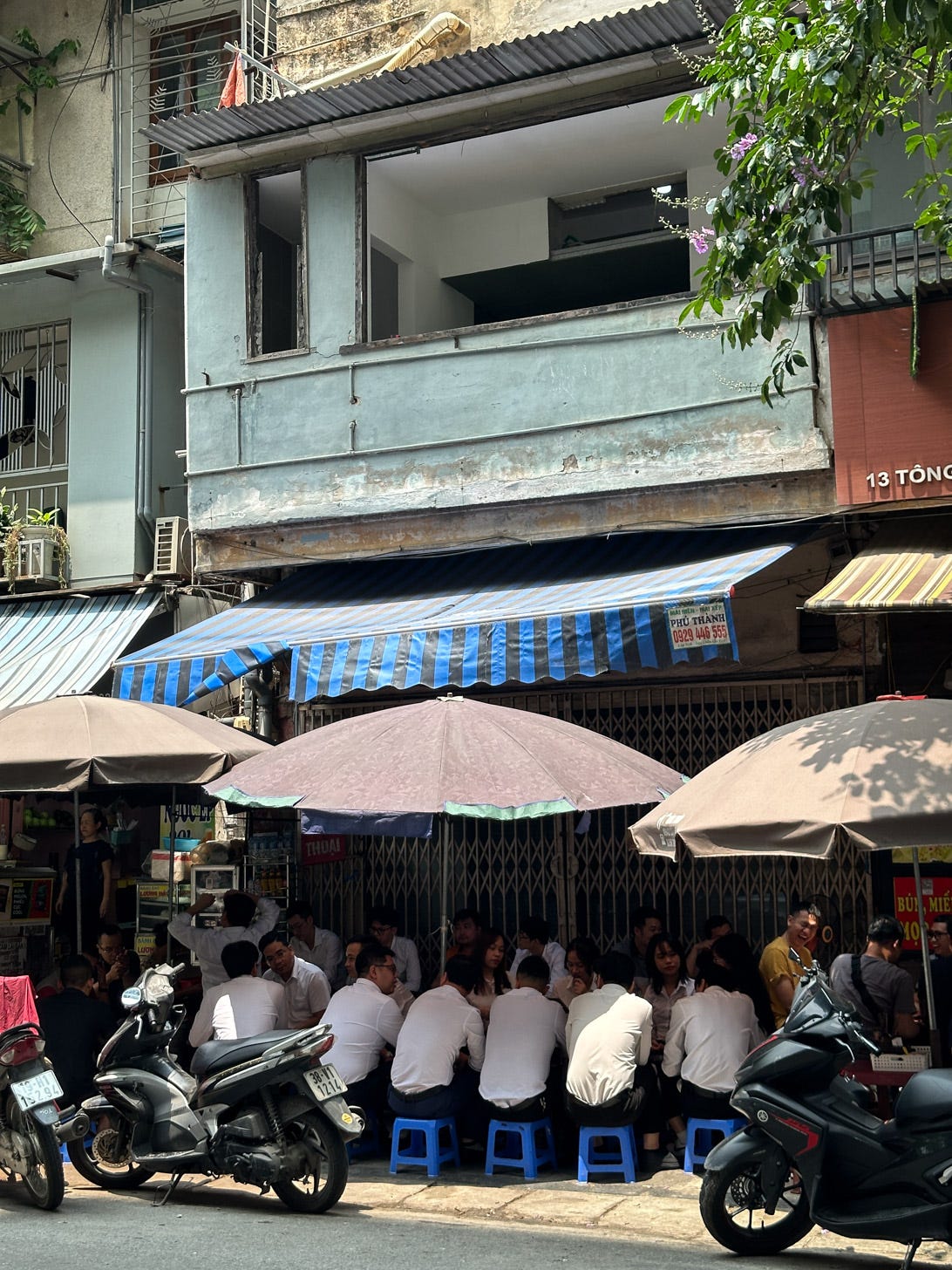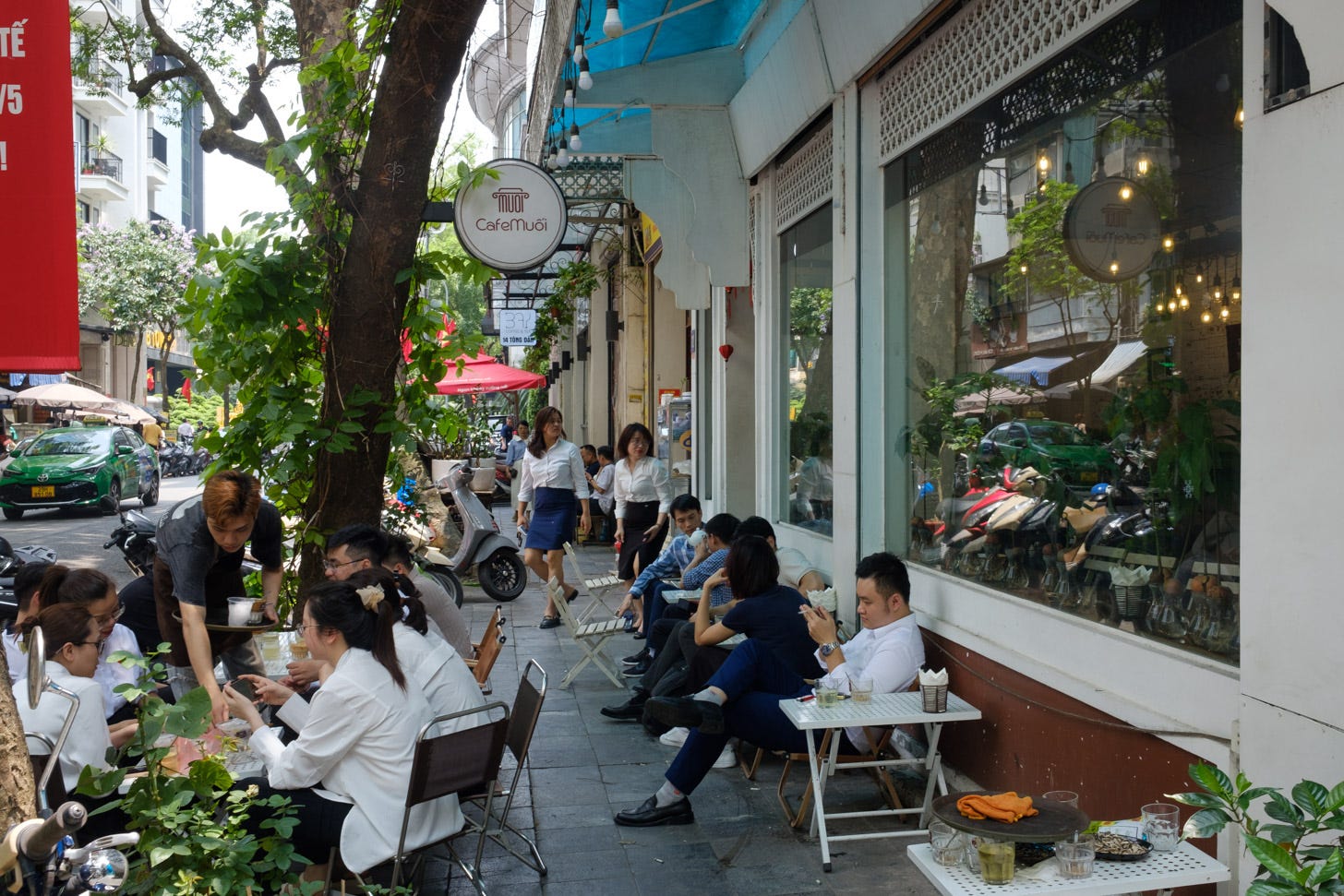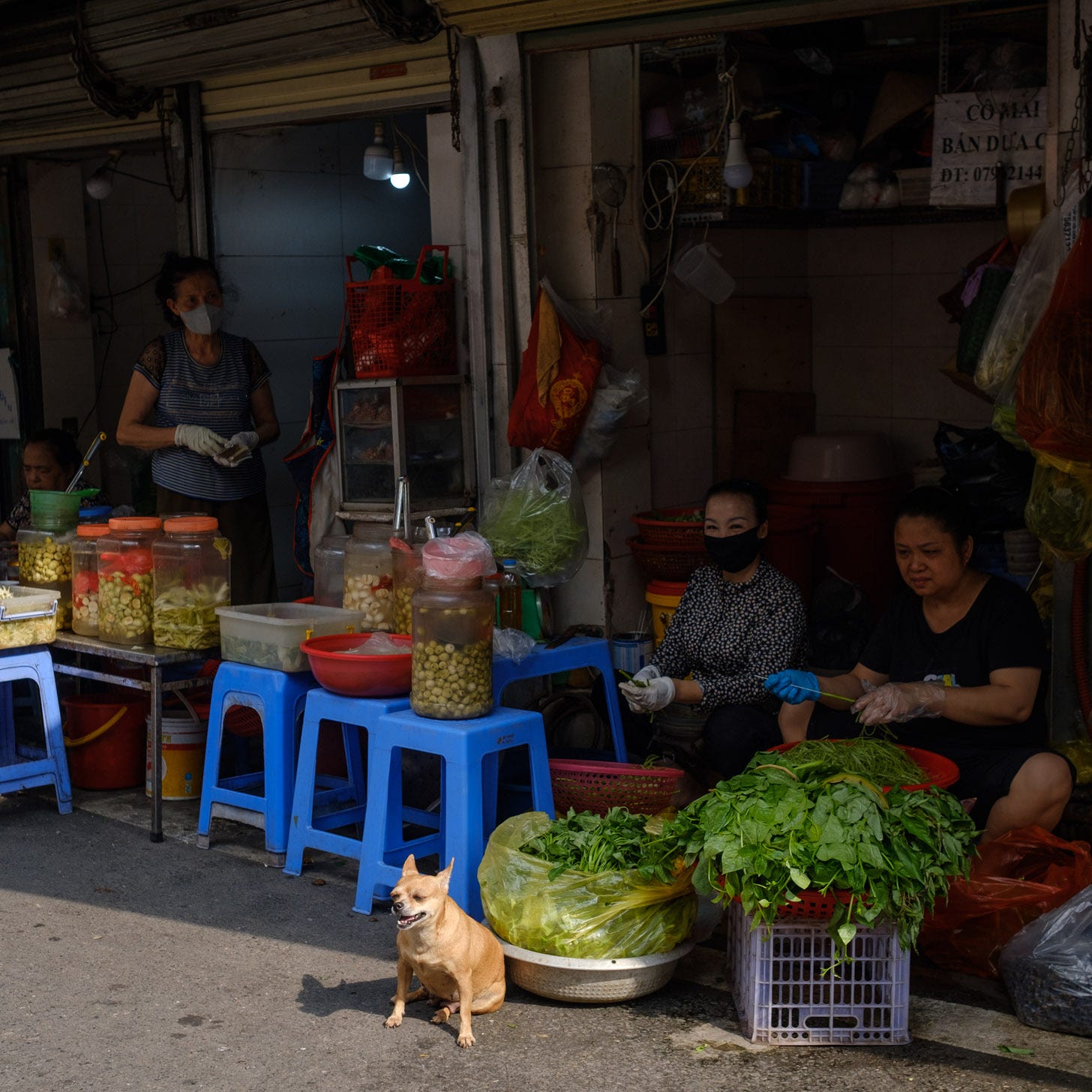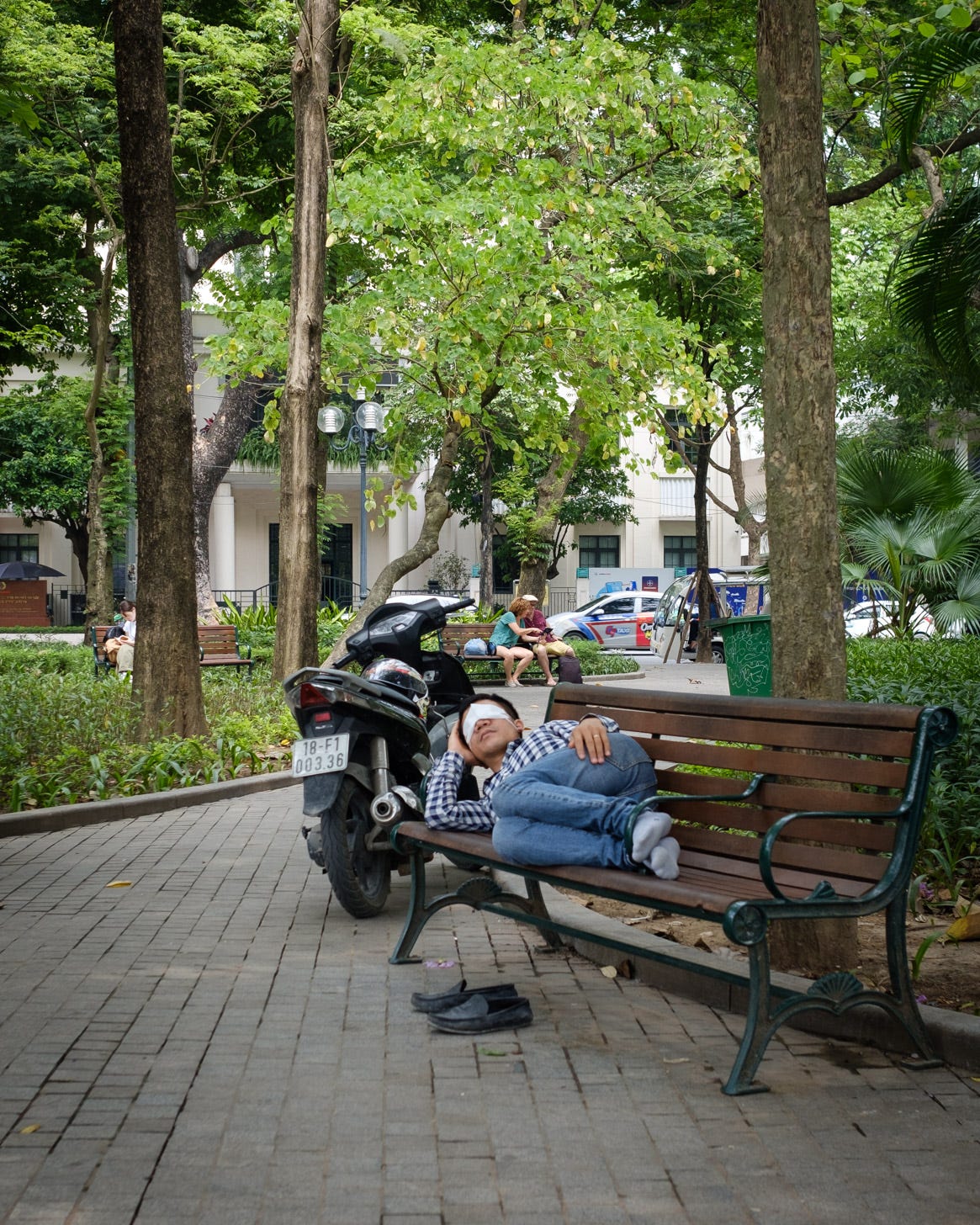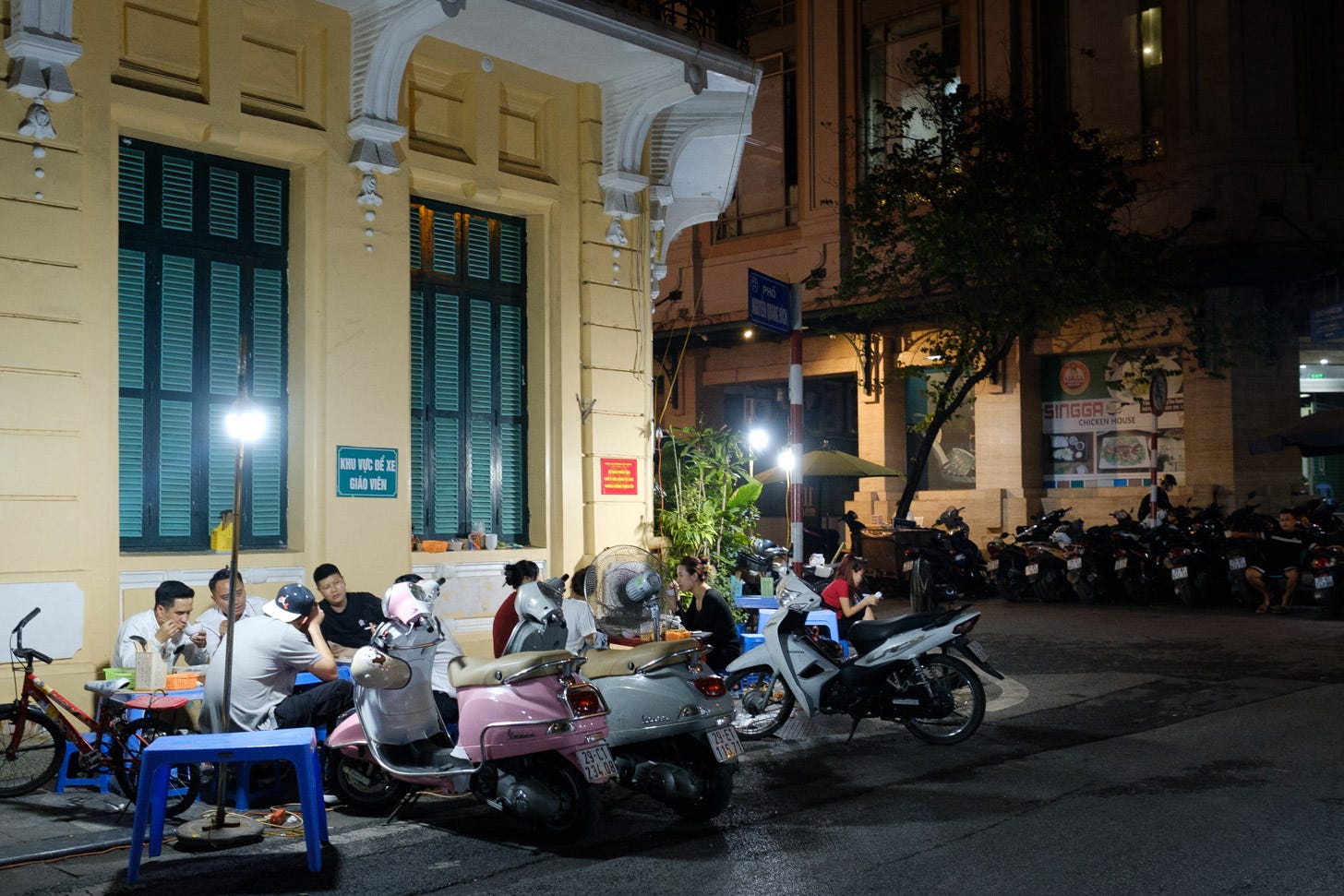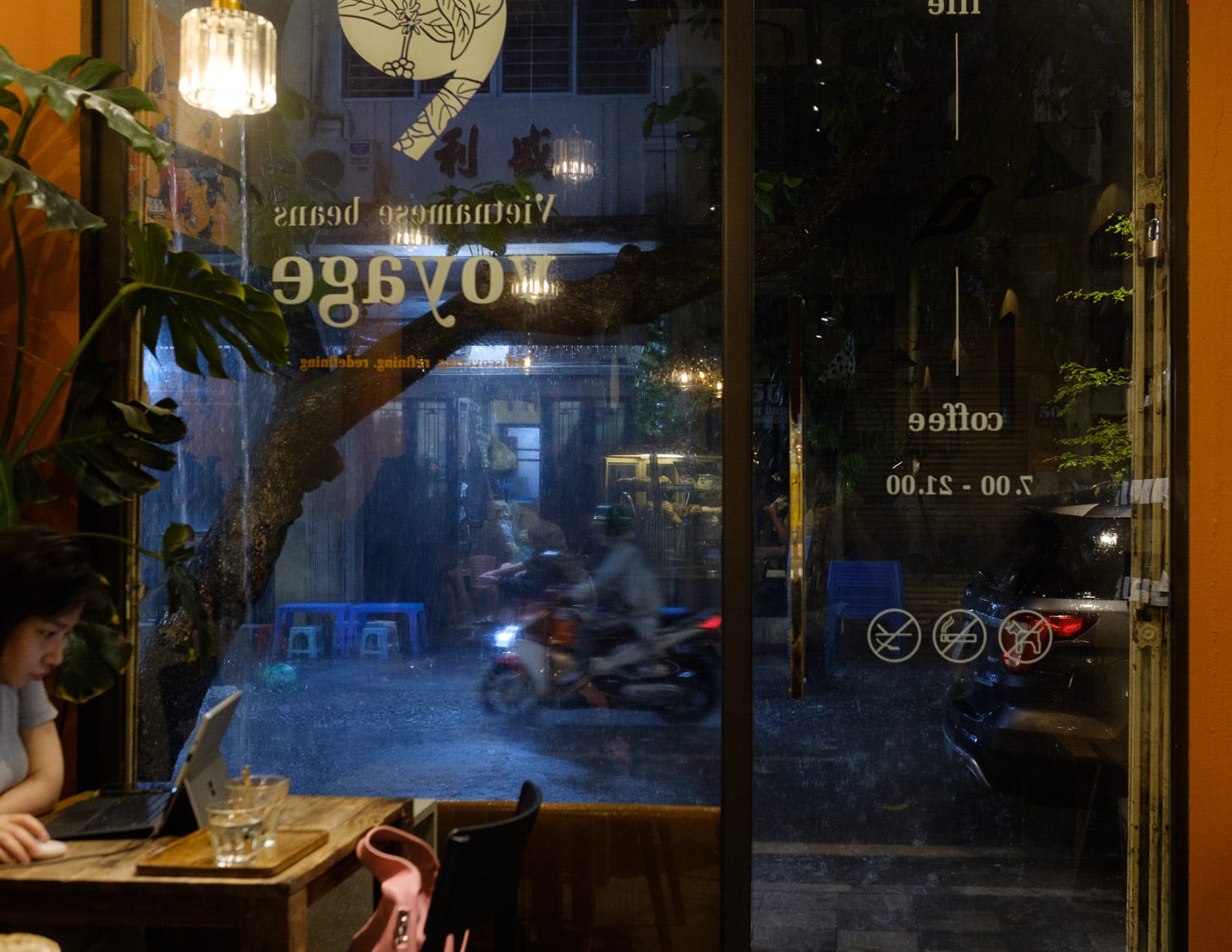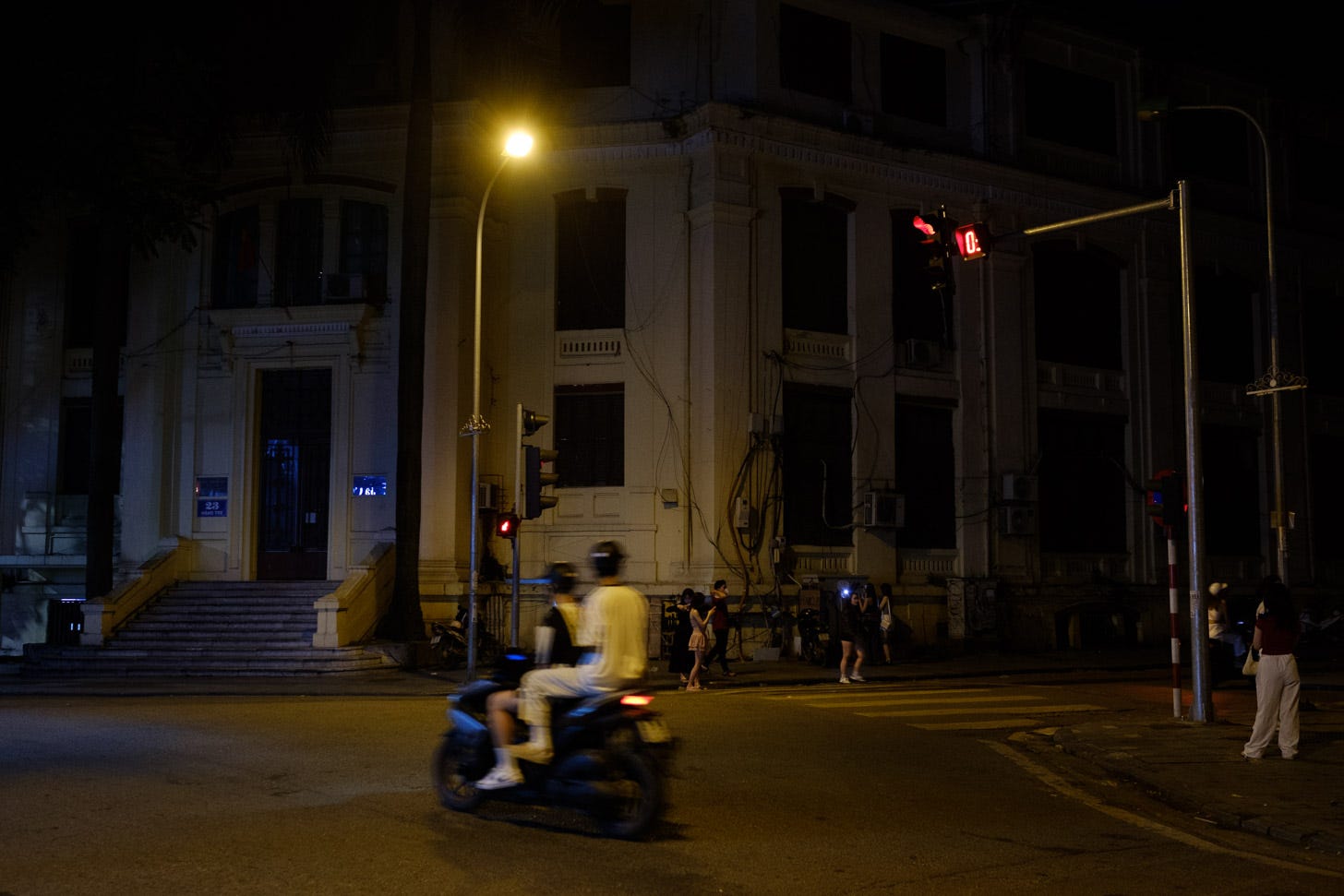Notes on Hanoi
Things I saw while walking the city's streets and peering out from inside its cafes.
However you found your way here, welcome! I’m Emily, and I write letters about how we seek and tell stories to make sense of a changing world and our place in it.
1./ That’s the gurgling of eighty or so water pumps in the courtyard of an old apartment building in the city’s French Quarter, where we stayed—with dense tangles of pipes snaking up the building, some five storeys high, to their respective apartments. The entrance gate is closed at midnight, and if you come back after you have to wake the guard—a wiry, crotchety uncle usually dressed in shorts and a t-shirt, who sleeps on a thin mattress lining a rigged wooden platform just inside the entrance gate—to be let in, though he seemed never to be expecting us despite the supposed agreement in place 😆 It seemed to be one of three Airbnbs in the building, from what I could make out from the arrow signs. It did make me think that, wherever affordable, I should cut back more on whole-apartment holiday rentals to refrain from taking up affordable permanent housing for locals, charming and “authentic”-feeling though this place was…
2./ The first time we left our apartment, we turned off our street and soon came upon the century-old Dien Hong park, bounded by busy roads. It was buzzing, so festive. People were playing badminton and cầu mây (we call it sepak takraw in Malaysia), sitting on mini plastic stools to chat over a snack, while pet dogs stared hungrily or took a leak. There’s a beautiful, very old, stone fountain originally built by the French (with just the right amount of patina, as W.C., an artist, would say) in the centre of the park: dragons weaving down slopes, toads spouting water—or they would be if the fountain hadn’t been left dry.
3./ Walking along Trang Thi street close to midnight, we segued into two long lines of teenagers flanking the street, hanging out on their parked motorcycles. People here seem to learn to ride motorcycles young, which gives them an element of freedom in a busy city, and I imagine their bikes serve as economical perches if they can’t yet afford to hang out too often in cafes and restaurants. I saw them sneaking glances at each other from across the street—Oh, that one’s cute, will they approach? An ice-cream shop nearby carried on a brisk business and a boy, bespectacled and dressed in a white t-shirt and shorts, a subtle swagger animating his shoulders, collected two ice creams and ambled across the road to a girl, also simply dressed, waiting with her friend on a bike. I turned to W.C., couldn’t help but smile. It all felt like something of a school dance!
4./ One of the things W.C. and I contend with while travelling, especially post-pandemic, is finding cafes that are open late but which remain in “cafe” mode rather than “bar” mode, so it’s bright enough that we can continue to read, write, draw after dinner. The accommodations we get don’t always have a desk, and even if they do, it’s nicer to be outside among the flow of people in a city. Our first night in Hanoi, before we had staked out a better spot, we went to a cafe-restaurant that was very dim to begin with, and then the power went out. A waitress opened the entrance door to allow the bright glow of the street lamp into the room, and at our illuminated corner table by the tall grilled window, W.C. and I continued to talk in the dark—probably about the act of travelling and its conceits and contradictions; having visited Bali recently, we have been talking about that quite a bit of late. When the lights didn’t come back on, the same waitress eventually brought us a fake candle, its “flame” dancing convincingly.
5./ Sitting in a restaurant in the Old Quarter northeast of Ho Hoan Kiem lake, looking out onto the street from our window perch, we saw two traffic policemen pull up three men who were huddled very cosily together on one motorbike. I couldn’t help but notice that the uniform of the traffic police in Hanoi is particularly pleasing: a light peachy tan, with masks in a matching colour even—which makes me think about how the tiniest detail of beauty can matter, add to the whole of something. (Many people still wore masks on the streets but I think it was more to protect themselves from air pollution than Covid?) The three men looked sheepish, like naughty schoolboys, as they dismounted the bike. The driver had to let one of the policemen commandeer it, before he climbed on obediently behind him. They sped off, leaving his two friends hanging back uncertainly. We continued to eat our meal, watching them eventually settle onto the stoop of a shopfront to wait.
6./ I very much liked the area we stayed in, some fifteen minutes walk southeast of Ho Hoan Kiem lake. It felt like a predominantly local neighbourhood, and carried a noticeably different vibe from the lake’s immediate vicinity, plied by trishaws who try to solicit you for a ride around town. Still, Hanoi in general didn’t feel too crowded by tourism and was very pleasant to visit. Many Vietnamese here, even those who work regularly with tourists, didn’t speak much English. It was unlike in the outskirts such as Ninh Binh or Sapa, where more people spoke English—perhaps because tourism is a more concentrated source of livelihood there in comparison to the city, where one can ply a greater variation of trades?—and when they didn’t, they resorted reflexively to Google speech translation. It surprised us how common that was, even among older people. They just whipped out their phones and started talking into it. Some things got lost in translation, of course, leading to some funny moments. Once I texted our accommodation ahead of time asking them if they could do something for us (I don’t remember what), and they replied, in English: “oh that’s too simple”.
7./ Since so many women here, too, ride bikes—as drivers and passengers, the humble helmet has been given a twist to better accommodate their ponytails and high buns, with an upside-down “U” carved out of its rear centre. Speaking of head gear, I also saw a few green pith-style helmets around town—if I remember correctly, on the heads of the rickshaw cyclists hailing tourists—which made me think of a couple of heritage hotels back in Malaysia and Singapore dating from the colonial era, where the security and concierge staff sport them to augment, I guess, the bygone vibes. Then, in Ninh Binh and Sapa, we saw some farmers wear them to stave off the sun’s blinding heat, which made me question my hitherto one-dimensional association of the hats as a colonial symbol…
8./ I liked walking about during the lunch hours and seeing working people in their glowing white shirts and black bottoms, hunkered over their low tables and little plastic chairs along the sidewalks. Perhaps it’s because I’m a freelancer and have no standard “lunch hours” to speak of, but I was also struck by their collective aesthetic. The uniformity of their work clothes made them look like students, or members of a political party…
9./ The last time I was in Vietnam, in Ho Chi Minh, I noticed that some things were smaller than usual: the plastic chairs spilling outside cafes on sidewalks, the toilet rolls—almost child-sized? Before this trip I wondered if I had simply imagined it, but I am happy to report: they are, in fact, smaller! The toilet rolls here are also sometimes missing that vertical hollow cardboard core, which makes unspooling a roll a little more difficult!
10./ Walking in downtown Hanoi is actually rather enjoyable, and less stressful than one might imagine, despite the challenges one faces in crossing the roads. We were lucky enough to have just missed early May’s heatwave; the buildings hanging over narrower streets in the central parts of town provide sufficient shade for us to walk without getting too flustered, and many streets have sidewalks. When they didn’t, the traffic at least moved slowly enough so that we could sidestep the cars and buses and motorcycles, even if that meant often having to hedge and look over our shoulders.
11./ Before coming to Hanoi, I read a very, very old Lonely Planet guidebook I had to Vietnam, just to know roughly which cities and regions I wanted to visit. Then I googled for its attractions and cafes and restaurants, which of course tends to bring up the same spots. Every list is derivative of other lists. I also looked up the hashtag #hanoi on Instagram to see what it would turn up, to find out what “the people” are doing, if there might be something that is still under the radar. In the end, I found this pottery shop-slash-cafe, a very calming space even though it faces a wide multi-lane road, and even though it was disproportionately populated by serious young influencers, local and foreign, making mini photoshoots and TikTok reels. I guess that’s what you get these days with hashtags. All of which made me think: perhaps, now, seeing the same recurring recommendations everywhere might push one to just exercise one’s own instincts? Walk around, see a place you like, check it out; and maybe you’ll have the satisfaction of having “discovered” for yourself something good?
12./ Looking at Booking.com reviews can be interesting for what it reveals about other people’s expectations and what they’re used to in their own country. On one hotel entry, people complained that the place was “dodgy” because it was down a narrow alley (the nondescript, not riotously snug kind), that it was a “scam” because the photos were not representative (true, it looked like a grand hotel rather than the rather more humble establishment it was, due to some sleight-of-hand wide-angle camerawork). We had booked this place for one night after returning from Ninh Binh, only belatedly read the reviews with some concern, and arrived in pouring rain, luckily, to realise it was neither dodgy nor a scam.
13./ Once, sitting inside Blackbird Coffee (the branch on Phố Đặng Dung) and looking out its large window overlooking the lively street, I saw a young woman sitting on the bench outside with her fringe rolled into a pink curler on her forehead. I thought it looked charming, though I suppose it could also hint at some sort of performed insouciance, in this day and age? We saw two other young women sporting the same during our week in Hanoi…
14./ Another night, past midnight, we came across a boy smashing something with a racquet against the wall of a building on a sidewalk. At first, we thought he was playing squash, and wondered what makes people here inhabit their city so constructively, despite the traffic, the way we Malaysians don’t quite do back in KL. Earlier that day, we had also seen a group of men drag a portable badminton net out onto the sidewalk to play on their lunch break. How much of this has to do with the way our city is designed, how much of it with ourselves? When we drew closer to the boy, we realised he wasn’t playing squash. He was actually hitting a shuttlecock 🤔—really, really hard—and filming a reel.
15./ For a place to break what was effectively our Airbnb’s midnight curfew, we found Xofa Cafe, which is open twenty-four hours, not far from the famous “train street”. It’s a bright, spacious place with big wooden tables, populated by many Vietnamese students banging over their laptops and workbooks while making jokes in between, seemingly burning the midnight oil. Remembering my younger self, I felt a lot of goodwill towards them, silently cheered them on.
Till next time, Hanoi ❤️
E.








